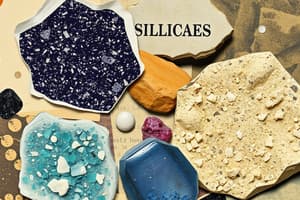Podcast
Questions and Answers
What are minerals?
What are minerals?
- Living organisms found in nature with specific characteristics
- Soft and crumbly materials found in nature with no specific shape
- Solid materials found in nature with specific chemicals and shapes (correct)
- Shiny and precious stones found in nature with no specific chemicals
Where are minerals found?
Where are minerals found?
- In plants and animals
- In nature, sometimes buried deep in the earth (correct)
- Only on the ground surface
- Exclusively in man-made structures
What are gems?
What are gems?
- Minerals found in plants and animals
- Shiny and precious stones (correct)
- Soft and crumbly minerals
- Hard and non-shiny minerals
Are minerals dead plants or animals?
Are minerals dead plants or animals?
What are minerals made up of?
What are minerals made up of?
What can be seen when looking at minerals under a microscope?
What can be seen when looking at minerals under a microscope?
Which mineral is commonly found in our food?
Which mineral is commonly found in our food?
What are silver, gold, and platinum classified as?
What are silver, gold, and platinum classified as?
What is iron primarily used for?
What is iron primarily used for?
What can happen if poisonous minerals are consumed?
What can happen if poisonous minerals are consumed?
How are minerals different from each other?
How are minerals different from each other?
What are atoms responsible for making in minerals?
What are atoms responsible for making in minerals?
Flashcards are hidden until you start studying
Study Notes
Minerals
- Naturally occurring solid substances
- Formed by geological processes
- Found in Earth's crust, rocks, and soil
- Composed of one or more elements, often in a specific ratio
- Examples: quartz, feldspar, mica, calcite
Gems
- Minerals with exceptional beauty, durability, and rarity
- Highly desired for jewelry and other decorative purposes
- Examples: diamonds, rubies, sapphires, emeralds
Mineral Composition
- Minerals are inorganic, meaning they are not made from living things
- Composed of atoms arranged in specific patterns
- Classified based on their chemical composition and crystal structure
Observing Minerals Microscopically
- Internal structure, including crystals and grain size
- Color variation within the mineral, often caused by impurities
- Presence of inclusions or other materials within the mineral
Everyday Minerals
- Salt (sodium chloride) is commonly found in food
- Iron is a key component of steel and other everyday items
- Silver, gold, and platinum are classified as precious metals, used in jewelry and various industrial applications
Mineral Differences and Applications
- Varying degrees of hardness, color, luster, and specific gravity
- Used in a wide range of industries, from construction to electronics
- Example: Iron is used for steel, a crucial material in countless industries
Mineral Hazards
- Some minerals are poisonous, such as arsenic and mercury
- Ingestion can lead to severe health problems including illness and death
Atom Roles in Minerals
- Atoms are the building blocks of minerals
- They bond together in specific arrangements to create the mineral's crystalline structure, ultimately determining its properties and characteristics.
Studying That Suits You
Use AI to generate personalized quizzes and flashcards to suit your learning preferences.




